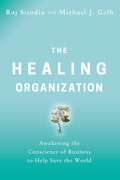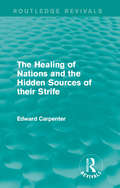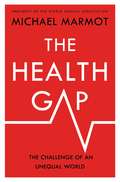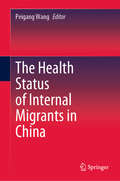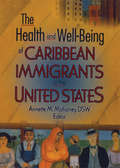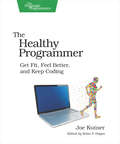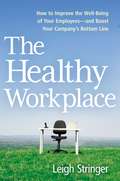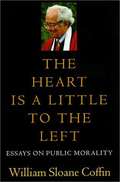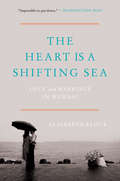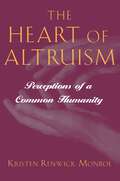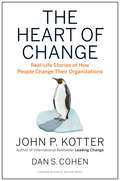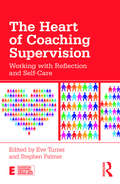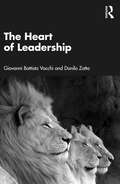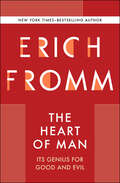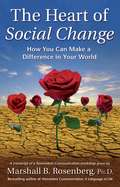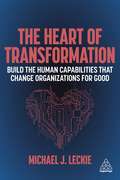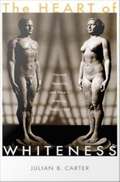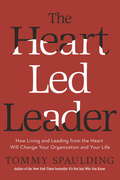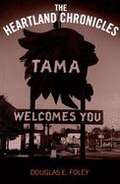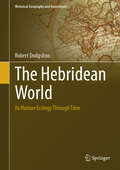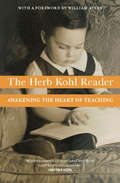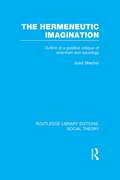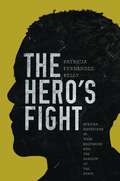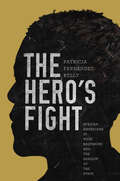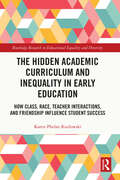- Table View
- List View
The Healing Organization: Awakening the Conscience of Business to Help Save the World
by Michael J. Gelb Raj SisodiaThe image of modern corporations has been shaped by a profits over people approach, but we are at a point where business must take the lead in healing the crises of our time. The Healing Organization shows how corporations can become healing forces.Conscious Capitalism pioneer Raj Sisodia and organizational innovation expert Michael J. Gelb were inspired to write this book because of the epidemic of unnecessary suffering connected with business, including the destruction of the environment; increasing numbers living paycheck-to-paycheck and barely surviving; and rising rates of depression and stress leading to chronic health problems.Based on extensive in-depth interviews and inspiring case studies, Sisodia and Gelb show how companies such as Shake Shack, Hyatt, KIND Healthy Snacks, Eileen Fisher, H-E-B, FIFCO, Jaipur Rugs and DTE Energy are healing their employees, customers, communities and other stakeholders. They represent a diverse sampling of industries and geographies, but they all have significant elements in common, besides being profitable enterprises:Their employees love coming to work.They have passionately loyal customers.They make a significant positive difference to the communities they serve.They preserve and restore the ecosystems in which they operate.The enmity and dividedness between those who champion unfettered capitalism and those who advocate socialism is exacerbating rather than solving our problems.In a world that urgently needs healing on many levels, this is a movement whose time has come. The Healing Organization shows how it can be done, how it is being done, and how you can begin to do it too.
The Healing of Nations and the Hidden Sources of their Strife (Routledge Revivals: The Collected Works of Edward Carpenter)
by Edward CarpenterOriginally published in 1915 in the middle of World War I, Carpenter explores the effects that the war was having on society and humankind as a whole from first-hand experience. In particular, papers focus on the differences between Germany and England, the causes of the war and suggestions for restoration and recovery when the war has ended. Carpenter details all of this in a realistic way drawing on matters such as class to put forward his anti-war stance as well as philosophical approaches to coping with tragedy. This title will be of interest to students of history, sociology and politics.
The Health Gap: The Challenge of an Unequal World
by Michael Marmot<p>In this groundbreaking book, Michael Marmot, president of the World Medical Association, reveals social injustice to be the greatest threat to global health <p>In Baltimore’s inner-city neighborhood of Upton/Druid Heights, a man’s life expectancy is sixty-three; not far away, in the Greater Roland Park/Poplar neighborhood, life expectancy is eighty-three. The same twenty-year avoidable disparity exists in the Calton and Lenzie neighborhoods of Glasgow, and in other cities around the world. <p>In Sierra Leone, one in 21 fifteen-year-old women will die in her fertile years of a maternal-related cause; in Italy, the figure is one in 17,100; but in the United States, which spends more on healthcare than any other country in the world, it is one in 1,800. Why? <p>Dramatic differences in health are not a simple matter of rich and poor; poverty alone doesn’t drive ill health, but inequality does. Indeed, suicide, heart disease, lung disease, obesity, and diabetes, for example, are all linked to social disadvantage. In every country, people at relative social disadvantage suffer health disadvantage and shorter lives. Within countries, the higher the social status of individuals, the better their health. These health inequalities defy the usual explanations. Conventional approaches to improving health have emphasized access to technical solutions and changes in the behavior of individuals, but these methods only go so far. What really makes a difference is creating the conditions for people to have control over their lives, to have the power to live as they want. Empowerment is the key to reducing health inequality and thereby improving the health of everyone. Marmot emphasizes that the rate of illness of a society as a whole determines how well it functions; the greater the health inequity, the greater the dysfunction. <p>Marmot underscores that we have the tools and resources materially to improve levels of health for individuals and societies around the world, and that to not do so would be a form of injustice. Citing powerful examples and startling statistics (“young men in the U.S. have less chance of surviving to sixty than young men in forty-nine other countries”), The Health Gap presents compelling evidence for a radical change in the way we think about health and indeed society, and inspires us to address the societal imbalances in power, money, and resources that work against health equity.</p>
The Health Status of Internal Migrants in China
by Peigang WangThis book describes the health status of internal migrants in China and explores a number of related factors, which include their physical health, mental health, fertility, social integration, the current state of basic public health services in China and so on. At present, there are 245 million migrants working in China, which means 1 out of every 6 people is a migrant. The large scale of the migrant population is accompanied by a range of problems concerning e.g. public health and medical services. This book draws on the latest findings and data to describe and analyze the health status of migrants in China from three perspectives – population distribution, time distribution and spatial distribution – and each chapter employs various advanced statistical methods, such as multilevel modeling and propensity score matching. Given the in-depth information it provides, the book will appeal to managers, clinicians, and researchers from many fields. It shares valuable insights into the health status of and related factors concerning China’s internal migrants, while also providing a sound scientific basis for decision-makers.
The Health and Well-Being of Caribbean Immigrants in the United States
by Annette MahoneyThe Health and Well-Being of Caribbean Immigrants in the United States is a timely addition to the knowledge base concerning the integration of this population into the fabric of American society. On the eve of the fortieth anniversary of the 1965 Immigration Reform Act, this book examines the relationship between immigrants from the Caribbean and the culture of the United States. This body of work provides resources for scholars and researchers and provides instrumental strategies for use in practice by counselors/social workers, curriculum developers, and immigration analysts.With this book, you will develop a new appreciation for the social capital immigrants bring with them, their adaptation to their new society, and the extent to which their distinctive characteristics promote or hinder their social mobility. Using tables, figures, and graphs, The Health and Well-Being of Caribbean Immigrants in the United States provides thorough analyses of broad-ranging issues and proposes viable solutions to the problems these immigrants face.In this important resource, expert educators, researchers, and community leaders address the unique challenges that affect this population, including: increased infant mortality rates increased HIV/AIDS among the Caribbean community the growing trend of violence and abuse among Caribbean and Caribbean-American youths the special needs of aging and elderly immigrants living in the United States the impact of the 1996 immigration legislation on Caribbean familiesThe Health and Well-Being of Caribbean Immigrants in the United States paints a clear picture of how these citizens are coping with the social, economic, and political aspects of the American way of life. This guide offers new findings and insight into the reality of the diverse immigrant Caribbean population, setting the stage for establishing groundbreaking initiatives to develop better support services. Innovative community-based approaches and culturally specific prescriptive intervention models make this book an integral source for social scientists, human service professionals, and policymakers.
The Healthy Programmer: Get Fit, Feel Better, and Keep Coding
by Joe KutnerPrinted in full color.To keep doing what you love, you need to maintain your own systems, not just the ones you write code for. Regular exercise and proper nutrition help you learn, remember, concentrate, and be creative--skills critical to doing your job well. Learn how to change your work habits, master exercises that make working at a computer more comfortable, and develop a plan to keep fit, healthy, and sharp for years to come.Small changes to your habits can improve your health--without getting in the way of your work. The Healthy Programmer gives you a daily plan of action that's incremental and iterative just like the software development processes you're used to. Every tip, trick, and best practice is backed up by the advice of doctors, scientists, therapists, nutritionists, and numerous fitness experts.We'll review the latest scientific research to understand how being healthy is good for your body and mind. You'll start by adding a small amount of simple activity to your day--no trips to the gym needed. You'll learn how to mitigate back pain, carpal tunnel syndrome, headaches, and many other common sources of pain. You'll also learn how to refactor your diet to properly fuel your body without gaining weight or feeling hungry. Then, you'll turn the exercises and activities into a pragmatic workout methodology that doesn't interfere with the demands of your job and may actually improve your cognitive skills.You'll also learn the secrets of prominent figures in the software community who turned their health around by making diet and exercise changes. Throughout, you'll track your progress with a "companion iPhone app".Finally, you'll learn how to make your healthy lifestyle pragmatic, attainable, and fun. If you're going to live well, you should enjoy it.DisclaimerThis book is intended only as an informative guide for those wishing to know more about health issues. In no way is this book intended to replace, countermand, or conflict with the advice given to you by your own healthcare provider including Physician, Nurse Practitioner, Physician Assistant, Registered Dietician, and other licensed professionals.Keep in mind that results vary from person to person. This book is not intended as a substitute for medical or nutritional advice from a healthcare provider or dietician. Some people have a medical history and/or condition and/or nutritional requirements that warrant individualized recommendations and, in some cases, medications and healthcare surveillance. Do not start, stop, or change medication and dietary recommendations without professional medical and/or Registered Dietician advice. A healthcare provider should be consulted if you are on medication or if there are any symptoms that may require diagnosis or medical attention. Do not change your diet if you are ill, or on medication except under the supervision of a healthcare provider. Neither this, nor any other book or discussion forum is intended to take the place of personalized medical care of treatment provided by your healthcare provider.This book was current as of January, 2013 and as new information becomes available through research, experience, or changes to product contents, some of the data in this book may become invalid. You should seek the most up to date information on your medical care and treatment from your health care professional. The ultimate decision concerning care should be made between you and your healthcare provider.Information in this book is general and is offered with no guarantees on the part of the author, editor or The Pragmatic Programmers, LLC. The author, editors and publisher disclaim all liability in connection with the use of this book.
The Healthy Workplace: How to Improve the Well-Being of Your Employees---and Boost Your Company's Bottom Line
by Leigh StringerIs your workplace working for you and your employees? Studies show that unhealthy work habits, like staring at computer screens and rushing through fast-food lunches are taking their toll in the form of increased absenteeism, lost productivity, and higher insurance costs--but it doesn't have to be that way.Companies such as Google, Apple, Aetna, and Johnson & Johnson have used innovative techniques to incorporate healthy habits and practices into the workday and into their culture--with impressive ROI. Packed with real-life examples and the latest research, The Healthy Workplace proves that it pays to invest in your people's well-being and reveals how to:Create a healthier, more energizing environmentReduce stress to enhance concentrationInspire movement at workUse choice architecture to encourage beneficial behaviorsSupport better sleepHeighten productivity without adding hours to the workdayFilled with tips for immediate improvement and guidelines for building a long-term plan, The Healthy Workplace will boost both employee well-being and the bottom line.
The Heart Is A Little to the Left: Essays on Public Morality
by William Sloane CoffinFrom the preface: "Today the currents of history are indeed churning into rapids and waterfalls. If we are to be equal to the times we live in and to the greater problems the future will bring, we had better learn to scorn trifles and strive to be far more imaginative and more generous in spirit. Above all, I believe we need to claim the kinship of all people, to recover the prophetic insight that we belong one to another, every one of us from the pope to the loneliest wino on the planet. From a religious perspective, that's the way God made us. From a Christian perspective, Christ died to keep us that way, which means that our sin is only and always that we put asunder what God has joined together."
The Heart Is a Shifting Sea: Love and Marriage in Mumbai
by Elizabeth FlockIn the vein of Behind the Beautiful Forevers, an intimate, deeply reported and revelatory examination of love, marriage, and the state of modern India—as witnessed through the lives of three very different couples in today’s Mumbai.In twenty-first-century India, tradition is colliding with Western culture, a clash that touches the lives of everyday Indians from the wealthiest to the poorest. While ethnicity, class, and religion are influencing the nation’s development, so too are pop culture and technology—an uneasy fusion whose impact is most evident in the institution of marriage.The Heart Is a Shifting Sea introduces three couples whose relationships illuminate these sweeping cultural shifts in dramatic ways: Veer and Maya, a forward-thinking professional couple whose union is tested by Maya’s desire for independence; Shahzad and Sabeena, whose desperation for a child becomes entwined with the changing face of Islam; and Ashok and Parvati, whose arranged marriage, made possible by an online matchmaker, blossoms into true love. Though these three middle-class couples are at different stages in their lives and come from diverse religious backgrounds, their stories build on one another to present a layered, nuanced, and fascinating mosaic of the universal challenges, possibilities, and promise of matrimony in its present state.Elizabeth Flock has observed the evolving state of India from inside Mumbai, its largest metropolis. She spent close to a decade getting to know these couples—listening to their stories and living in their homes, where she was privy to countless moments of marital joy, inevitable frustration, dramatic upheaval, and whispered confessions and secrets. The result is a phenomenal feat of reportage that is both an enthralling portrait of a nation in the midst of transition and an unforgettable look at the universal mysteries of love and marriage that connect us all.
The Heart of Altruism: Perceptions of a Common Humanity
by Kristen Renwick MonroeIs all human behavior based on self-interest? Many social and biological theories would argue so, but such a perspective does not explain the many truly heroic acts committed by people willing to risk their lives to help others. In The Heart of Altruism, Kristen Renwick Monroe boldly lays the groundwork for a social theory receptive to altruism by examining the experiences described by altruists themselves: from Otto, a German businessman who rescued over a hundred Jews in Nazi Germany, to Lucille, a newspaper poetry editor, who, armed with her cane, saved a young girl who was being raped. Monroe's honest and moving interviews with these little-known heroes enable her to explore the causes of altruism and the differences between altruists and other people. By delineating an overarching perspective of humanity shared by altruists, Monroe demonstrates how social theories may begin to account for altruism and debunks the notions of scientific inevitability that stem from an overemphasis on self-interest. As Monroe has discovered, the financial and religious backgrounds of altruists vary greatly--as do their views on issues such as welfare, civil rights, and morality. Altruists do, however, share a certain way of looking at the world: where the rest of us see a stranger, altruists see a fellow human being. It is this perspective that many social theories overlook. Monroe restores altruism to a general theory of ethical political behavior. She argues that to understand what makes one person act out of concern for others and not the self, we need to ask how that individual's perspective sets the range of options he or she finds available.
The Heart of Change: Real-Life Stories of How People Change Their Organizations
by John P. Kotter Dan S. CohenMoving beyond the process of changeWhy is change so hard? Because in order to make any transformation successful, you must change more than just the structure and operations of an organization-you need to change people's behavior. And that is never easy.The Heart of Change is your guide to helping people think and feel differently in order to meet your shared goals. According to bestselling author and renowned leadership expert John Kotter and coauthor Dan Cohen, this focus on connecting with people's emotions is what will spark the behavior change and actions that lead to success. Now freshly designed, The Heart of Change is the engaging and essential complement to Kotter's worldwide bestseller Leading Change.Building off of Kotter's revolutionary eight-step process, this book vividly illustrates how large-scale change can work. With real-life stories of people in organizations, the authors show how teams and individuals get motivated and activated to overcome obstacles to change-and produce spectacular results. Kotter and Cohen argue that change initiatives often fail because leaders rely too exclusively on data and analysis to get buy-in from their teams instead of creatively showing or doing something that appeals to their emotions and inspires them to spring into action. They call this the see-feel-change dynamic, and it is crucial for the success of any true organizational transformation.Refreshingly clear and eminently practical, The Heart of Change is required reading for anyone facing the challenges inherent in leading change.
The Heart of Coaching Supervision: Working with Reflection and Self-Care (Essential Coaching Skills and Knowledge)
by Stephen Palmer Eve TurnerThe Heart of Coaching Supervision takes us on a journey that starts with understanding who we are, and why we do what we do the way we do it, so that we can help those we work with understand themselves and their practice. The journey includes our background and personal and professional influences and considers the need for self-resourcing to resource others. It examines our being alongside our doing, to ensure that we can provide the best possible service to all those we work with. The book’s highly experienced contributors provide a unique perspective on supervision’s benefits. The chapters cover themes that support self-discovery and resourcing including the three Ps of supervision and coaching, diversity and inclusion, resourcing, working with intense emotions and the self as instrument. Nancy Kline’s Thinking Environment© is explored in a supervision context alongside creative forms of reflective and expressive writing and resourcing through a peer supervision chain. The Heart of Coaching Supervision also includes ten engaging, international case studies, considering the role of supervision in depth. A key contribution to the field, the book is essential reading for all coaches and mentors, coaching supervisors and psychologists, managers in a coaching role and anyone in a helping profession or leadership position wanting to better understand the wide benefits of supervision.
The Heart of Leadership
by Danilo Zatta Giovanni Battista VacchiSquarely aimed at leaders and aspiring leaders, The Heart of Leadership, written by two renowned management experts, presents practical examples and engaging insights to answer the key question of how to be a successful leader.This book reveals the key characteristics of a great leader and shows you how to develop the skills needed to motivate your team and overcome challenges. Leadership means successfully taking your place at the head of an enterprise and is both a shared journey and an adventure over the course of a career. Using an engaging and accessible style throughout, the book maps out how to achieve tangible results. It presents portrayals of some of history’s greatest leaders, from Gandhi to Steve Jobs, from Angela Merkel to Lisa Su, in order to inspire and help develop your own top leadership skills.This book is essential reading for CEOs, CFOs, HR managers, entrepreneurs, trainers, and those who are seeking a leadership position in an organization and want to understand how to succeed within it.
The Heart of Man: Its Genius for Good and Evil
by Erich FrommThe acclaimed social psychologist and New York Times–bestselling author of The Art of Loving discusses the nature of evil and humanity&’s capacity for it. Originally published in 1964, The Heart of Man was influenced by turbulent times. Average Americans were suffering from different forms of evil, including a rise in juvenile delinquency. On a grander scale, the threat of nuclear war loomed over the nation, and President John F. Kennedy had been assassinated. What could drive humanity to do things such as these? In The Heart of Man, renowned humanist philosopher and psychoanalyst Erich Fromm investigates man&’s capacity to destroy, his narcissism, and his incestuous fixation. He expands upon ideas he presented in Escape from Freedom, Man for Himself, and The Art of Loving, and examines the essence of evil, as well as the choice between good and evil. He also explores man&’s ability to destroy and further considers freedom, aggression, destructiveness, and violence. &“The Heart of Man questions human nature itself, from the forms of violence that plague it to individual and social narcissism to how the positive value of &“love of life&” can potentially outweigh the destructive &“syndrome of decay&” caused by the love of death and other harmful tendencies of thought.&” —Midwest Book Review
The Heart of Social Change: How to Make a Difference in Your World
by Marshall B. RosenbergThe tenets of Nonviolent Communication are applied to a variety of settings, including the classroom and the home, in these booklets on how to resolve conflict peacefully. Illustrative exercises, sample stories, and role-playing activities offer the opportunity for self-evaluation, discovery, and application. This insightful perspective on effective social change is illustrated with how-to examples.
The Heart of Transformation: Build the Human Capabilities that Change Organizations for Good
by Michael J. LeckieTechnology doesn't transform organizations - people do.In an era of technological and constant change, companies are bombarded with urgent advice to become more agile, lean and digital. Billions are spent on digital transformation efforts with the promise that these efforts will increase competitive advantage. Yet even when only 30 percent of these efforts succeed, this hard-won competitive advantage only lasts until the next disruption before the cycle repeats, causing transformation fatigue. The Heart of Transformation breaks this cycle by suggesting that the pace and complexity of change is too great and too complex to be addressed by a single change effort or transformation. The answer lies in the organization's greatest asset: its people. In the face of complexity, it is the people and their ability to adapt and learn that are the true engine of organizational change. The Heart of Transformation outlines the six human capabilities (Exploring before Executing, Learning before Knowing, Pathfinding before Path Following, Changing before Protecting, Innovating before Replicating and Humanizing before Organizing) that create competitive advantage for organizations organically, quickly and from the bottom up. The book translates those capabilities into simple and immediately adoptable behaviors for leaders and every person in the organization. It offers a new standard for organizational excellence, one that is dependent on the organization's ability to be deeply human. Instead of offering another one-size-fits-all solution, The Heart of Transformation reveals that by leveraging our most human of capabilities, organizations can change better, faster and achieve excellence much quicker than imagined.
The Heart of Whiteness: Normal Sexuality and Race in America, 1880-1940
by Julian B. CarterIn this groundbreaking study, Julian Carter demonstrates that between 1880 and 1940, cultural discourses of whiteness and heterosexuality fused to form a new concept of the "normal" American. Gilded Age elites defined white civilization as the triumphant achievement of exceptional people hewing to a relational ethic of strict self-discipline for the common good. During the early twentieth century, that racial and relational ideal was reconceived in more inclusive terms as "normality," something toward which everyone should strive. The appearance of inclusiveness helped make "normality" appear consistent with the self-image of a racially diverse republic; nonetheless, "normality" was gauged largely in terms of adherence to erotic and emotional conventions that gained cultural significance through their association with arguments for the legitimacy of white political and social dominance. At the same time, the affectionate, reproductive heterosexuality of "normal" married couples became increasingly central to legitimate membership in the nation. Carter builds her intricate argument from detailed readings of an array of popular texts, focusing on how sex education for children and marital advice for adults provided significant venues for the dissemination of the new ideal of normality. She concludes that because its overt concerns were love, marriage, and babies, normality discourse facilitated white evasiveness about racial inequality. The ostensible focus of "normality" on matters of sexuality provided a superficially race-neutral conceptual structure that whites could and did use to evade engagement with the unequal relations of power that continue to shape American life today.
The Heart-Led Leader: How Living and Leading from the Heart Will Change Your Organization and Your Life
by Tommy SpauldingIn his first book, It's Not Just Who You Know (which rose to #2 on the New York Times bestseller list), world renowned leadership speaker and former CEO of Up with People Tommy Spaulding talked about the power of building genuine and lasting relationships both personally and professionally. In his new book, The Heart-Led Leader, Spaulding turns his focus to ourselves - to who we are. Authentic leaders, Spaulding says, live and lead from the heart. The values and principles that guide our lives and shape our ability to lead others is far more important than our title, or our ability to crunch numbers, or the impressive degrees we display on our walls. To effect true transformational change, heart-led leaders draw on the qualities of humility, vulnerability, transparency, empathy and love. Illustrated with stories from his own life, and from some of the exceptional leaders he has met and worked with over the years, Spaulding unpacks what those qualities mean, talks about the 18-inch journey from the head to the heart - from our intellect to our emotions - and shows us how to incorporate them into our careers, into how we manage and lead others, and into how we live our lives. It is a vision of leadership that has the power to transform everything we do, and the lives of everyone we touch.From the Hardcover edition.
The Heartland Chronicles
by Douglas E. FoleyA tale of Indians and whites living together in a small Iowa community. The Heartland Chronicles is also about an anthropologist returning to his hometown and boyhood memories. <P><P> More than simply a study of racial injustice. Douglas E. Foley's multi-layered historical account incorporates the perspectives of both the white and Mesquaki Indian groups. Foley has created this historical context by exploring his own memories and those of his Indian and white informants, by reading five decades of local newspapers, and by examining the fieldnotes of thirty-five anthropologists who worked among the Mesquakis from 1948 to 1959. (During this period the University of Chicago's Department of Anthropology had a field school on the Mesquaki settlement.) His research results in a complex portrayal of the double structuring of perceptions of people on opposite sides of a cultural border. <P><P> This study depicts how ethnic and racial boundaries are produced narratively through mutual misrecognition. Like most Native Americans, the Mesquakis have survived numerous popular and academic misrepresentations of their culture. In response, a post-World War II generation of "progressive-traditionalist" tribal leaders have maintained their sacred religious traditions and have produced a variety of anti-assimilationist literary and artistic productions. Ultimately, their ongoing civil rights struggle and new gambling casino have helped the tribe attain greater economic and political autonomy. As a result, the Mesquakis now stand on the precipice of modernity and a capitalist consumer culture.
The Hebridean World: Its Human Ecology Through Time (Historical Geography and Geosciences)
by Robert DodgshonThe Hebrides has long been seen as an area that, when considered over time, was slow to absorb change. Indeed, from the nineteenth century onwards, it attracted the attention of scholars for being seen as having not just the oldest rocks in Europe but also, some of its oldest cultural practices and institutional forms. This unchanging ‘archaic’ character has continued to attract a great deal of research but, over recent decades, a counter view has emerged that highlights the changes that the region did experience. This book argues the case for the latter by drawing out how the institutional forms around which the region and its farming communities were organised changed over time. As background. It highlights the importance of understanding two key inter-related features that underpinned these changes: the low output of Hebridean farming with its high frequency of poor harvests and the range of environmental hazards that beset the region. Brought together, the interaction between these two features makes the survival strategies adopted by communities an important part of the region’s history. Because society/environment interactions are at the heart of the problem, the book’s discussion is presented as a study in human ecology. One of the benchmark studies of the region in modern times, or Sir Fraser Darling’s The West Highland Problem: A Study in Human Ecology (OUP, 1955) adopted such an approach. This book gives this human ecological perspective on the region a greater time-depth. In addition to a Preface and an Epilogue, it is divided into 12 chapters: Title: The Hebridean World: Its Ecological History Through Time Preface 1: The Hebrides: Their Physical Endowment and Its Challenges 2: The Oldest Cultural Landscapes 3: The Hebridean Mix: Picts, Scots and Vikings 4: How Land was Occupied Before Crofting 5: How the Land was Farmed before Crofting 6: Landscapes of Summer: the Shielings 7: The Inter Tidal and Beyond: the Harvest of Shore and Sea 8:Survival on the Margins 9: The Landscapes of Crofting 10: The Harvesting and Processing of Grain 11: The Clearances for Sheep and Deer 12: Hebridean Housing and Settlement Epilogue
The Herb Kohl Reader: Awakening the Heart of Teaching
by Herbert KohlThe best writing from a lifetime in the trenches and at the typewriter, from the renowned and much-beloved National Book Award–winning educator. In more than forty books on subjects ranging from social justice to mathematics, morality to parenthood, Herb Kohl has earned a place as one of our foremost &“educators who write.&” With Marian Wright Edelman, Mike Rose, Lisa Delpit, and Vivian Paley among his fans, Kohl is &“a singular figure in education,&” as William Ayers says in his foreword, &“it&’s clear that Herb Kohl&’s influence has resonated, echoed, and multiplied.&” Now, for the first time, readers can find collected in one place key essays and excerpts spanning the whole of Kohl&’s career, including practical as well as theoretical writings. Selections come from Kohl&’s classic 36 Children, his National Book Award–winning The View from the Oak (co-authored with his wife Judy), and all his best-known and beloved books. The Herb Kohl Reader is destined to become a major new resource for old fans and a new generation of teachers and parents. &“Kohl has created his own brand of teaching . . . [He is] a remarkable teacher who discovered in his first teaching assignment that in education he could keep playing with toys, didn&’t have to stop learning, and could use what he knew in the service of others.&” —Lisa Delpit, The New York Times &“An infinitely vulnerable and honest human being who has made it his vocation to peddle hope.&” —Jonathan Kozol
The Hermeneutic Imagination: Outline of a Positive Critique of Scientism and Sociology (Routledge Library Editions: Social Theory)
by Josef BleicherIn his previous book, Contemporary Hermeneutics, Josef Bleicher offered an introduction to the subject, locating it mainly within the philosophy of social science, and looking at the profound impact it is having on a wide range of intellectual pursuits. This book follows on from this and expounds the author's view that the development of the hermeneutic imagination is an indispensable condition for reflexive sociological work and emancipatory social practice. Dr Bleicher examines the various approaches to sociology – empiricist, functionalist, structuralist, interpretive, critical – by reference to a hermeneutic paradigm, and shows how the hermeneutic imagination leads to a redirection in sociology, away from scientistic presuppositions and towards an awareness of the dialogue which links the subject and object in the study of social phenomena. He argues that by allowing the hermeneutic imagination to develop, it is possible to counter the steering of social processes on the basis of technocratic imperatives, and to provide a rational anticipation of a better future.
The Hero's Fight
by Patricia Fernández-KellyBaltimore was once a vibrant manufacturing town, but today, with factory closings and steady job loss since the 1970s, it is home to some of the most impoverished neighborhoods in America. The Hero's Fight provides an intimate look at the effects of deindustrialization on the lives of Baltimore's urban poor, and sheds critical light on the unintended consequences of welfare policy on our most vulnerable communities.Drawing on her own uniquely immersive brand of fieldwork, conducted over the course of a decade in the neighborhoods of West Baltimore, Patricia Fernández-Kelly tells the stories of people like D. B. Wilson, Big Floyd, Towanda, and others whom the American welfare state treats with a mixture of contempt and pity--what Fernández-Kelly calls "ambivalent benevolence." She shows how growing up poor in the richest nation in the world involves daily interactions with agents of the state, an experience that differs significantly from that of more affluent populations. While ordinary Americans are treated as citizens and consumers, deprived and racially segregated populations are seen as objects of surveillance, containment, and punishment. Fernández-Kelly provides new insights into such topics as globalization and its effects on industrial decline and employment, the changing meanings of masculinity and femininity among the poor, social and cultural capital in poor neighborhoods, and the unique roles played by religion and entrepreneurship in destitute communities.Blending compelling portraits with in-depth scholarly analysis, The Hero's Fight explores how the welfare state contributes to the perpetuation of urban poverty in America.
The Hero's Fight: African Americans in West Baltimore and the Shadow of the State
by Patricia Fernández-KellyBaltimore was once a vibrant manufacturing town, but today, with factory closings and steady job loss since the 1970s, it is home to some of the most impoverished neighborhoods in America. The Hero's Fight provides an intimate look at the effects of deindustrialization on the lives of Baltimore's urban poor, and sheds critical light on the unintended consequences of welfare policy on our most vulnerable communities.Drawing on her own uniquely immersive brand of fieldwork, conducted over the course of a decade in the neighborhoods of West Baltimore, Patricia Fernández-Kelly tells the stories of people like D. B. Wilson, Big Floyd, Towanda, and others whom the American welfare state treats with a mixture of contempt and pity--what Fernández-Kelly calls "ambivalent benevolence." She shows how growing up poor in the richest nation in the world involves daily interactions with agents of the state, an experience that differs significantly from that of more affluent populations. While ordinary Americans are treated as citizens and consumers, deprived and racially segregated populations are seen as objects of surveillance, containment, and punishment. Fernández-Kelly provides new insights into such topics as globalization and its effects on industrial decline and employment, the changing meanings of masculinity and femininity among the poor, social and cultural capital in poor neighborhoods, and the unique roles played by religion and entrepreneurship in destitute communities.Blending compelling portraits with in-depth scholarly analysis, The Hero's Fight explores how the welfare state contributes to the perpetuation of urban poverty in America.
The Hidden Academic Curriculum and Inequality in Early Education: How Class, Race, Teacher Interactions, and Friendship Influence Student Success (Routledge Research in Educational Equality and Diversity)
by Karen Phelan KozlowskiDrawing on a rich ethnographic study conducted in first grade classrooms in the US, this book reveals the potentially invisible, yet significant ways that race and social class impact student success in the earliest years of their schooling. The Hidden Academic Curriculum and Inequality in Early Education: How Class, Race, Teacher Interactions, and Friendship Influence Student Success explores key differences observed between the classroom interactions and academic behaviors of racially, socially, and ethnically diverse first grade students. Chapters offer in-depth analysis of the ways in which classed and racialized coaching by families, differentiated teacher-student interactions, and racially segregated friendships play out in the school environment, and ultimately influence a child’s ability to decode the academic hidden curriculum. This in turn, dictates a child’s understanding and ability to perform the specific skills associated with academic success. Ultimately, the text highlights the critical need for improved understanding of how in- and out-of-school factors impact child behaviors, and offers key recommendations to prevent the perpetuation of racial and socioeconomic inequalities in schools and classrooms. This insightful volume will be of particular interest to postgraduate students, researchers, and academics in the fields of Early Childhood Education and the Sociology of Education. Those with a focus on racial, ethnic, and social inequalities more broadly, will also find the book of interest.
